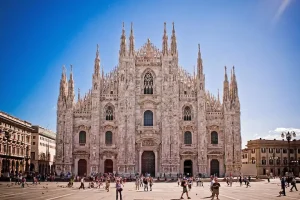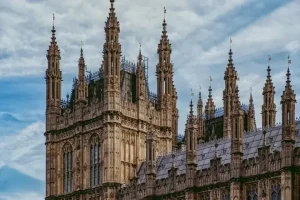Modern Islamic architecture is actually a combination of traditional Islamic architectural principles and the new needs of the contemporary era. This architectural style seeks to create spaces that are not only consistent with the cultural and religious identity of Islam, but also provide beauty and functionality together by using advanced technologies and new materials. Modern Islamic architecture offers a new way to design buildings and public spaces in response to challenges such as globalization, social changes and environmental needs. Today and in this article, we are going to introduce and review modern Islamic architecture from 0 to 100. Follow us until the end.
What is modern Islamic architecture?
Modern Islamic architecture is an emerging style that seeks to combine the traditional principles of Islamic architecture with the needs and possibilities of the modern world. This style, while preserving Islamic cultural and religious elements, uses new innovations and technologies to create a beautiful, functional, and contemporary environment. Modern Islamic architecture attempts to create a new space that is in harmony with the principles of Islamic aesthetics and at the same time acts in a practical and up-to-date way in response to today’s environmental and social challenges.
This style is especially important in Islamic countries that are in the process of transitioning from traditional to modern architecture. In this type of architecture, designers, inspired by classical Islamic architecture, seek to design spaces that represent cultural and Islamic identity not only by inspiration from historical principles, but also by using contemporary materials and techniques, in accordance with the needs of the day. In other words, modern Islamic architecture is a combination of traditional beauties and the modern world.
In modern Islamic architecture, we can see the use of curved forms, special lighting, unique porches and domes, while new materials such as glass, steel, and concrete are also used. The design of open spaces and the connection between the inside and outside of the building is a feature that is clearly visible in many modern Islamic architectural projects. These features create a balance between the traditional spirit and modern needs in the design.


Key Features of Modern Islamic Architecture
A key feature of modern Islamic architecture is the emphasis on the use of Islamic forms and geometries. These forms, such as geometric motifs, arches, and intricate designs, are used in innovative ways in modern buildings. In this style, geometry is used as a common language between different cultures, creating designs that are both beautiful and understandable.
The use of light and shadow is another important feature of modern Islamic architecture. In many traditional Islamic buildings, playing with natural light and creating different shadows was considered not only as a means of controlling temperature and ventilation of the space, but also as an aesthetic element. In modern architecture, these principles have been updated with the use of large windows and movable glass. In particular, the design of open spaces and greater connection between the interior and exterior of the building allows natural light to flow effectively into the interior spaces.
Sustainability and energy are also a vital issue in modern Islamic architecture. Many projects in this style use green technologies and sustainable designs to reduce energy consumption and conserve natural resources. This approach is not only consistent with the principles of Islamic architecture that seek to preserve the environment, but is also recognized as a necessity in today’s world where climate change is increasing.
The influence of culture on modern Islamic architecture
Islamic culture plays an important role in shaping modern Islamic architecture. In this style, designers seek to preserve the cultural and religious identity of Islam through the use of specific symbols and forms. However, unlike traditional architecture, which was more directly related to religious principles and verses of the Quran, in modern Islamic architecture these symbols are used abstractly and to convey current and universal concepts.
Identity in modern Islamic architecture is important not only in terms of aesthetics but also in terms of functionality. For example, many modern Islamic buildings have designs that respect the privacy of individuals in the Islamic community, such as high walls, open spaces for social interaction, and spaces for worship and reflection. These features allow modern Islamic architecture to effectively meet the cultural and social needs of the Islamic community.
In this type of architecture, the emphasis on creating spiritual and relaxing spaces is of particular importance, especially in public and religious places. As a result, in the design of mosques, schools and other religious buildings, the interior space is designed in such a way that the users feel close to God and have a sense of spiritual peace. This approach is especially evident in the design of modern mosques, where, in addition to preserving the characteristics of Islamic architecture, new materials and special designs are used to create a modern and at the same time spiritual space.

The role of technology in modern Islamic architecture
New technologies and modern materials have played a significant role in the formation of modern Islamic architecture. The use of double-glazed windows, steel, and advanced concrete has allowed architects to design lighter, stronger, and better-performing structures. These materials not only increase the strength of the building but also allow designers to create structures with complex and elegant designs, which are essential in modern Islamic architecture.
One of the prominent uses of new technologies in modern Islamic architecture is the use of intelligent building systems. These systems can automatically control temperature, light, ventilation, and even security of the building, which improves the quality of life in these spaces. For example, in many modern Islamic architecture projects, intelligent ventilation systems are used to control the temperature in indoor spaces to provide greater comfort for users while consuming less energy.
In addition, the use of advanced techniques in structural design, such as 3D designs and Building Information Modeling (BIM), enables architects and engineers to optimize designs and reduce construction and maintenance costs of projects. These technologies in modern Islamic architecture allow architects to more accurately use complex algorithms and geometric patterns in their designs that were impossible to achieve in the past.
Outstanding examples of modern Islamic architecture
Modern Islamic architecture is known worldwide for its outstanding works that have attracted the attention of many architects and designers. One such example is the King Abdullah Mosque in Jeddah, Saudi Arabia. This mosque has a very modern appearance, but at the same time with an Islamic identity, using modern designs and advanced materials. In this mosque, new technologies have been used for natural ventilation, lighting and energy efficiency.
Another example is the Doha Islamic Cultural Center in Qatar, designed by the famous architect Jean Nouvel. By combining traditional materials such as stone and plaster with glass and metal, this project perfectly blends Islamic identity with contemporary architecture. This center is known not only as a religious space but also as a cultural and artistic symbol in the Persian Gulf region.
The Noor Islam Mosque in Singapore is also known as an outstanding example of modern Islamic architecture, whose design is a combination of modernity and Islamic architectural principles. Using simple and beautiful designs, this mosque has created a spiritual and relaxing atmosphere that is attractive to locals and tourists.


The difference between modern Islamic architecture and traditional and classical architecture
One of the main differences between modern Islamic architecture and traditional styles is the extensive use of new materials and technologies. Traditional Islamic architecture used more natural materials such as brick, plaster and wood, but modern architecture uses new materials such as double-glazed glass, steel and advanced concrete. This difference in materials has led to lighter, stronger and more freely designed structures.
Another important difference is the design methods. Traditional Islamic architecture relied more on geometric forms, such as arches and domes. However, in modern architecture, these forms have been expressed in an abstract way and through digital design techniques. The use of 3D design software and Building Information Modeling (BIM) allows architects to create complex and creative designs that were difficult in the past.
Finally, modern Islamic architecture places a significant emphasis on functional aspects. For example, in the design of public spaces, the priority is to create comfortable, efficient, and environmentally friendly environments. While traditional architecture emphasized religious and symbolic aspects, modern architecture combines these two aspects and emphasizes functionality and beauty simultaneously.
Challenges of Modern Islamic Architecture
One of the main challenges in modern Islamic architecture is to preserve cultural and religious identity against the effects of globalization and architectural innovations. Designers must simultaneously use modern technologies to preserve the traditional principles of Islamic architecture in order to create contemporary spaces that are at the same time culturally authentic. This challenge is especially felt in non-Islamic countries where Islamic architecture is less well known.
On the other hand, this architectural style provides many opportunities for interaction between cultures and introducing the potential of Islamic architecture to the world. The use of modern designs and new materials can act as a bridge between the past and the future and enhance the status of Islamic architecture on a global level. Especially in the Middle East and Islamic countries, this style can be considered as a symbol of progress and innovation while preserving traditions.
Finally, despite the challenges ahead, modern Islamic architecture can act as an effective tool for solving environmental issues and sustainable design in architecture. Given the increasing population growth and the need for more efficient buildings, modern Islamic architecture can play a key role in the development of sustainable cities.
The future of Islamic architecture
The future of Islamic architecture in today’s world is influenced by global trends as well as local needs. Architects are striving to find solutions that meet modern needs and sustainable development while preserving Islamic cultural heritage. This coexistence between modernity and tradition could lead to more efficient and environmentally friendly urban spaces in the future.
Advances in technology and new materials are giving architects the opportunity to present more innovative designs while maintaining traditional principles. For example, in the design of mosques and religious buildings, the use of green technologies and designs appropriate to different climates can contribute to greater energy efficiency and reduce negative environmental impacts.
Finally, the future of modern Islamic architecture will increasingly focus on emphasizing designs that are appropriate to today’s social and cultural needs. This type of architecture can be a bridge between the past and the future, one that both honors traditional values and seeks new developments in response to contemporary challenges.
Final Words
As you can see, in this article, we have introduced and examined modern Islamic architecture from 0 to 100. We have learned that modern Islamic architecture, as a new style, attempts to present the traditional principles of Islamic architecture in a contemporary and up-to-date format. By using new materials, new technologies, and design methods based on Islamic aesthetics, this style creates functional and spiritual spaces that are in line with the modern needs of society. At the same time, there are challenges that architects must overcome intelligently so that they can innovate in their designs while maintaining their Islamic identity. The future of modern Islamic architecture, especially with the increasing attention to sustainability issues, can act as a bridge between tradition and modernity and provide solutions to the environmental and social challenges of today’s world.
Thank you for your support until the end of this article, we hope that the information provided has been useful to you. Ohaddeco Group specializes in the design and implementation of various types of wooden acoustic wall covering and wooden thermowall. You can contact us to place an order for these products and get more information.




